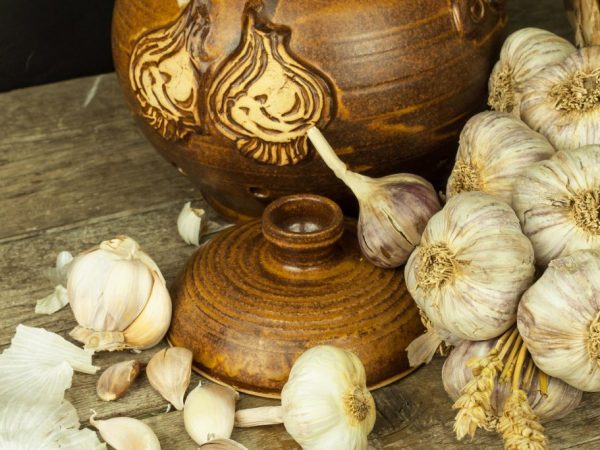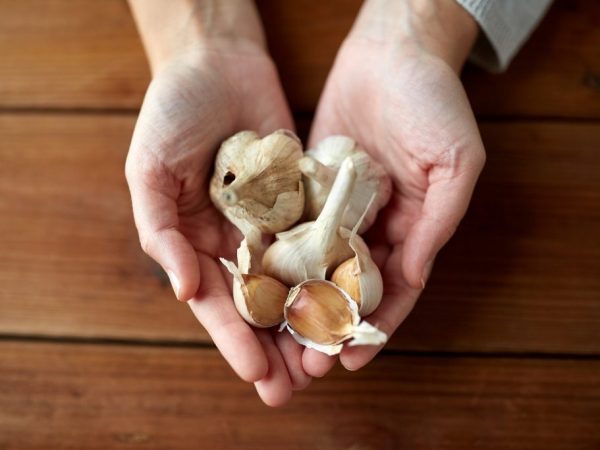The principle of processing garlic before planting
Garlic is a vegetable crop that has long been a favorite addition to many dishes and a remedy for colds. Every seasoned farmer knows that processing garlic before planting is very important for the healthy and proper growth of a vegetable.

The principle of processing garlic before planting
Selection rules
To plant a vegetable like garlic, you will need to select the best vegetable heads. You can plant whole tubers or detached cloves. In any case, for planting, you need to choose healthy seeds without damage and rotting areas. Take species with pinkish or bluish scales.
It is best to plant varieties that are appropriate for your region, otherwise you will have to wait until the culture has acclimated before you get a normal harvest. Getting used to weather conditions and soil quality lasts about 2 years.
Preparing to disembark
First of all, you need to decide how to process the garlic before planting in order to grow strong and healthy fruits. To avoid unwanted diseases and pests, planting material should be thoroughly disinfected.
Even the strongest in appearance teeth can be carriers of parasites or diseases. Those seeds that are planted for several years are especially susceptible to diseases. It is in order to get rid of unwanted pests that planting material needs to be changed every year.
There are several ways to prepare for planting.
- Pre-planting manipulation in the form of soaking the cloves in saline will help avoid rotting and nematode infection. Such procedures should be done correctly in the spring.
- Before planting a vegetable crop for the winter, you can process it with potassium permanganate. To do this, you will need to soak the planting material for 8-10 hours in a slightly pink solution of potassium permanganate. The method can also be used for planting onions.
- The most effective and versatile processing of a vegetable crop in the spring before planting is a solution of copper sulfate. A 1% copper solution is used for the purpose of disinfection and prevention: seeds are immersed in it for half an hour, and then they are planted in the ground.
- Soaking in an ash solution is also a method that will help kill many pests. To prepare it, you should take 500 gr. ash and boil them in 2 liters. water for half an hour. Immerse our planting material in the cooled solution and leave for several hours. The method is well suited for planting spring seed, as well as for sowing for the winter.
Anti-fungus treatment
The processing of garlic in the fall before planting should be carefully thought out, because the tubers will remain in the ground for the winter and they should be provided with good protection from pests and diseases. Especially the cloves of winter garlic should be protected against fungal infections caused by mold.

We use proven means
Fitosporin
If the seeds are treated with Fitosporin, then you can not worry about the future of your harvest.The advantage of Fitosporin is the ability to apply it at any stage of plant development.
Copper sulfate
Also, a sure way to protect future seedlings from fungal infections for the winter is fertilization with copper sulfate. Prepare the solution according to the scheme: 1 hour spoon of copper sulfate 10 liters of water. Such flavoring will also give a disinfecting effect, and will help to avoid the development of mold at the stage of storing the seed in the soil.
Fungicide Maxim
To save the future collection from a fungal infection, with which the vegetable crop becomes infected through seeds and soil, the Maxim fungicide should be used.
Maxim is completely safe to use, it belongs to a new chemical class of phenylpyrroles. In this connection, it has a mild effect and maximum effect, and also stimulates the growth of culture. The chemical agent creates invisible protection of the root system, which lasts for a long time. That is why Maxim is used in the processing of winter garlic.
Rot and mold treatment
Often, rot and mold can provoke weeds that grow in close proximity to vegetable crops. Sometimes, to get rid of them, you need to resort to chemical treatment. Herbicides will reliably destroy the rhizomes of weeds and will not affect the fruits growing in your garden. In addition to weeds, such preparations also eliminate diseases caused by mold and help in the fight against many pests.
Fundazol
For example, you can use an insecticide called Fundazole. The tool belongs to very dangerous and toxic substances, therefore it should be used clearly according to the instructions and in compliance with all safety measures.
The drug is used in two ways:
- application to the soil;
- irrigation of leaves
The action is aimed at the destruction of harmful insects such as aphids, many types of ticks and leaf beetles. The remedy defeats Nematoda, Late blight and Cladosporium. Also, to eliminate weeds and some diseases, drugs such as Galigan and Goal are suitable. They belong to the group of highly toxic substances. Often used to combat unwanted vegetation.
It is important to remember that if you do not observe the correct proportions when using chemicals, you can cause irreparable harm to health. Before using the product, make sure that you are doing everything right.
Fertilization rules
In order for your crop to be rich, it is necessary to fertilize the soil before planting vegetables. You should not listen to those who talk about the uselessness of fertilizing the soil for planting garlic. Fertilization is essential for healthy growth and development of the vegetable look. Fertilizer should be applied to the soil two weeks in advance, or even a month before planting.
When flavored, copper is used in a proportion of 1 tbsp. spoon for 10-12 liters of water. Among organic fertilizers, humus 4kg and superphosphate 20g can be used. To fertilize the soil, chicken droppings or dung are great.
Liquid fertilizer Valagro plantoform is used for feeding. A big plus is that Valagro can be mixed with many types of pesticides. Plantofol should be used in case of poor absorption of the rhizome. Poor conductivity of nutrients occurs due to cold weather, abundant moisture and alkalization of the soil. Method of fertilizing through the leaves.
Dissolve the drug in the proportions: 300 grams of the product per 100 liters of water in the open field and 150 grams per 100 liters in the closed ground. Processing can be carried out at intervals of at least a week.


